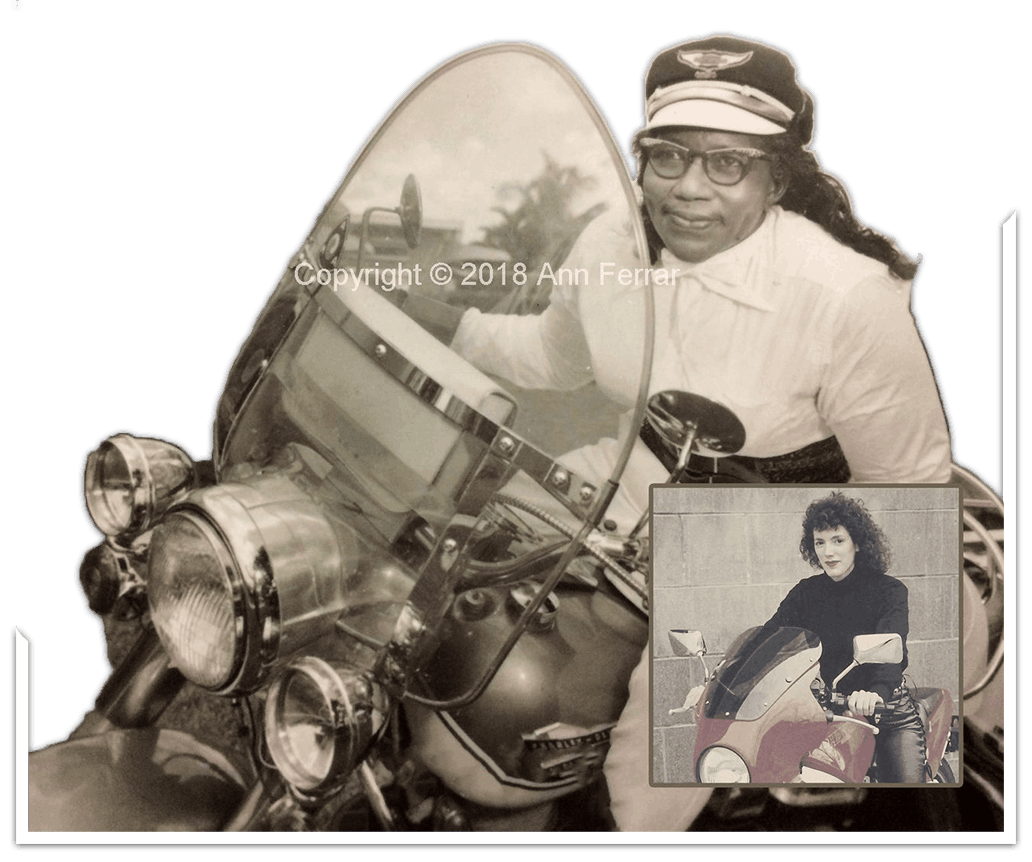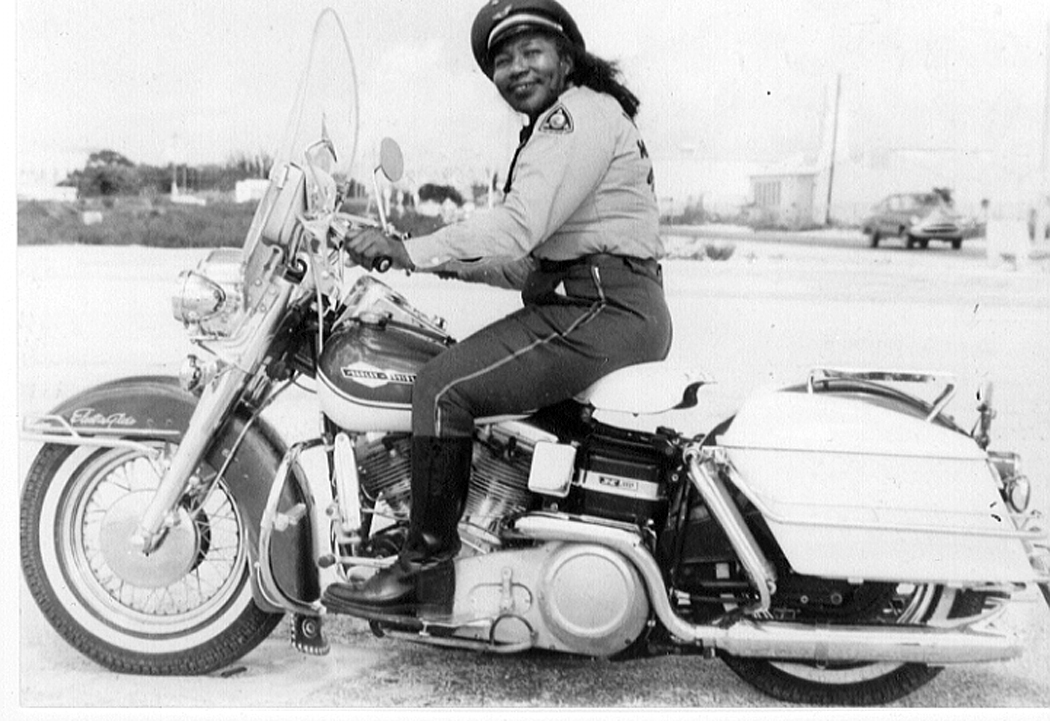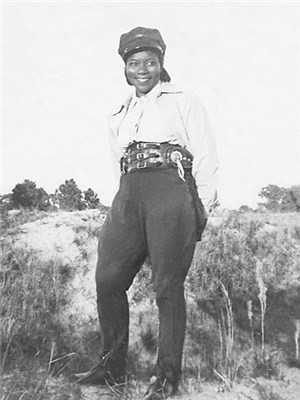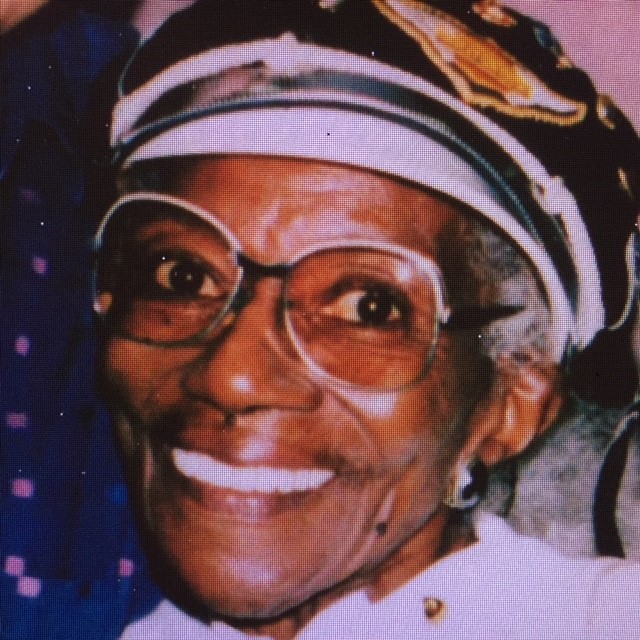African American Queen of the Road
Bessie Stringfield: Stories of Emotional Connection (Part 3)
By Ann Ferrar
The original stories of Bessie Stringfield, African American motorcycling pioneer, were written in the 1990s by Ann Ferrar, an author, friend and protégé of Bessie. Ferrar's narratives shed light on Bessie's hidden achievements in the pre-Civil Rights era. In PART 3 of this retrospective, Ann explores the bridge between her stories and the emotional reaction of Bessie's 21st century fans. Ferrar's coming book is the definitive biography "African American Queen of the Road: Bessie Stringfield: A Woman's Journey Through Race, Faith, Resilience and the Road." The book contains details of Bessie's life known only to Bessie and Ann.

© Copyright 1990-2024, Ann Ferrar. Ann Ferrar reserves all rights to this content and to her earlier stories of Bessie Stringfield, upon which this content is based. Library of Congress Copyright Registration Numbers TXu-2-160-705; TXu-2-088-760, et al. WGA Registration I338479, et al. These narratives, written by the author with her expression of thought and other original, primary-sourced story elements, are protected against theft by copyright and intellectual property laws. This material and Ferrar's other stories on Bessie Stringfield are NOT in the public domain for unauthorized use by other parties. Strictly prohibited are adaptations and other derivative, imitative works in any media or format, non-fiction or fiction. Please respect the author's rights and the wishes of Bessie Stringfield.
Bessie Stringfield: A Personal Legacy Project
The Bridge Between My Stories and Bessie's Posthumous Fame
By Ann Ferrar
In my view, Bessie Stringfield's strength, resilience, love and faith-based courage in the face of bigotry and sexism are what made her extraordinary, and that is why I knew I had to preserve and write her story. In my earliest narratives, I called her a one-woman civil rights movement. While Bessie did not get into "good trouble" as defined by the late civil rights leader John Lewis, Bessie got into "good mischief." My narratives described how Bessie chose an unusual way to assert her freedom—that which can only be felt in the wind on a motorcycle. Bessie, born in 1911, began riding motorcycles while still a teenager. She told me that she toured the country eight times during her 60-year riding career.
In Parts 1 and 2 of this website, I took a retrospective look at my original narratives of Bessie Stringfield's adventures between the late 1920s through the 1940s. Here in Part 3, I look back at my stories of how Bessie forged her own version of freedom in post-World War II Miami. In those stories, I described her escapades on her Harleys as bold and audacious. For one, she founded and led a group of mostly Black working men in her Iron Horse Motorcycle Club. During the mid-1960s, they had group rides and weekend gatherings, though suffice it to say that not all of her neighbors were "fans." The club disbanded circa 1970-1971, and Bessie, per her usual modus operandi, went her own way. Once she lost touch with her old club, they were gone from her life.
The Miami Police Department had a certain view of Bessie, at least in the beginning. I described how Bessie dealt with repeated hassles from the police; today we call it racial profiling. Bessie protested to the precinct captain. With skillful moves, she demonstrated to him that she had more than enough talent to handle her big bike in traffic. Finally, the harassment stopped. In that era, Bessie also became licensed as a practical nurse or LPN (which is not the same as a registered nurse or RN).
During that time, some local onlookers nicknamed Bessie Stringfield the "Negro motorcycle queen" and later the "motorcycle queen of Miami." These were never formal titles and people knew very little about the real woman behind these monikers. A few years ago on social media, the pop-culture label "rebel icon" appeared in a short, viral video about Bessie and it caught on, even though her millions of new fans know very little about the real woman today. They know only the highlights that I released in my short-form stories.
In my coming definitive biography, African American Queen of the Road: Bessie Stringfield: A Woman's Journey Through Race, Faith, Resilience and the Road, I am delving deeper into her life, drawing upon my exclusive audio tapes of Bessie and other proprietary resources. My stories are the original, primary-sourced stories of Bessie Stringfield.

For now, I can tell you that Bessie Stringfield, while friendly to those in her circle, was essentially a mystery. On her bikes she was an aloof, fleeting figure cruising past the eyes of onlookers. Bessie kept her cards close to her chest. She was a private citizen, by no means a public figure. Bessie told me, "I didn't want nobody [sic] knowing my business except for the Man Upstairs." And thus no one—not her casual Iron Horse buddies, and not even her husbands—really knew what made her tick. They did not know much about her beyond the version of Bessie standing in front of them during different phases of her life. Her Iron Horse club lasted six or seven years, a short life span for a biker club. I spent time with some of Bessie's closest peers, including her last husband, who confirmed this as well as her secretive, independent nature.
As a senior, Bessie was still riding Harleys for as long as she was physically able. In one of our last recorded conversations, she said, "I told the doctor that if I don't ride, I won't live long. And so I never did quit." But in reality, her chronic heart condition had already forced her to retreat from the road. In 1993, at the age of 82, she succumbed to her illness. Bessie had told me, "They say my heart is three times the size it's supposed to be." I have always felt this is an apt metaphor for an unconventional woman whose heart and spirited determination have touched so many lives.
For me, as the author-originator and steward of the story of Bessie Stringfield, it has been fascinating to watch the building of a bridge between my stories of Bessie and how she is perceived and admired by fans around the world today. I have watched how Bessie has risen in stature from hidden figure to posthumous global legend. Her legacy far transcends motorcycling. Today, Bessie Stringfield is regarded as a culturally significant figure to a new generation that recognizes her bravery as a woman of color and her defiance of traditional gender roles.
_________
Long before this age of renewed female empowerment and overdue
recognition of Black lives, I have always felt Bessie Stringfield should stand out
in the quest for inspiring hidden figures from the past.”
—Ann Ferrar
_________
It has been gratifying to hear from African American women who have told me they feel an emotional connection to Bessie Stringfield. Black women and their male peers hold Bessie up as a role model of cultural pride; they say they're proud of her for being unapologetically Black. I have received hundreds of emails, Facebook messages and comments posted online from people of all races, including many who have never been on a motorcycle. My readers come from across the USA, Canada, South America and Europe, and all the way from Australia, New Zealand and India. It is clear that one doesn't have to be a motorcycle enthusiast, or a person of color, or a woman, to be inspired by Bessie Stringfield.
I have been interviewed about Bessie Stringfield for major media ranging from The New York Times to the German news and culture magazine Der Spiegel, to Vice.com for the LGBTQ community. This far-reaching coverage shows that Bessie's story appeals to a universal audience as well as to marginalized groups. I have been privileged to introduce Bessie to the world so that she could receive the much-deserved recognition that eluded her during her own lifetime. As her friend and as the biographer in whom Bessie placed her trust, I fulfilled my promise to my late friend. From where I sit, all of this demonstrates the positive side of the internet's reach.
However, on a different level, the worldwide popularity of the inseparable conjoined twins—Bessie Stringfield and my stories on Bessie Stringfield—has led some people to take advantage of that popularity for their own gain. That is the downside of the internet and social media, when posthumous fame coincides with the vagaries of the web. It has become a part of Bessie's story that can no longer be ignored, so I won't sugar-coat it. Because of the spread of my stories on the web, Bessie has received the global recognition she deserves—which was my goal all along. However, some people chopped off my byline, feeding my stories into the internet content-mill, where they have been pirated and plagiarized over and over. This resulted in a Wikipedia entry on Bessie that cites recycled, reductive articles and other media that lifted from my works, without citing my original, primary-sourced, copyrighted works. The recycled material has been juggled and passed along so many times by others, that urban myths and errors have crept in as well.

other parties without prior written permission from the author.
Bessie Stringfield is recognized now as a pioneer for overcoming racial and gender bias in one of the most difficult periods in American history. She was posthumously inducted into the American Motorcycle Hall of Fame in 2002 because the nominating board learned about Bessie's achievements from my stories.
My position as the only knowledgeable source for the complete spectrum of Bessie's life—including that which is celebrated, that which is still unpublished, and even that which is controversial—comes with responsibilities. My first responsibility is to Bessie Stringfield, who entrusted me with her story and who cannot speak for herself. And I also have a responsibility regarding that which she shared with me in confidence. For instance, she kept secrets about her past that she chose to escape from.
Bessie told everyone she'd been born in Kingston, Jamaica, that she was brought to New England by her biological father, abandoned there, and then adopted by whites. Yet Bessie was born in the southeastern region of the United States to mixed-race parents and it was she who left. However, when Bessie gave me the gift of her life story, she asked me not to write about certain sensitive things until well after her death. I have respected Bessie's wishes, never writing about certain details of her private life.
I held fast to that promise in 2018 when The New York Times featured Bessie in a series of obituaries, meant to pay belated respects to notable yet overlooked women of color. The Times asked me to reminisce about Bessie, but I would not discuss the sensitive matters of Bessie's early life and identity that she had confided to me. I explained that the gray areas of Bessie's birth and childhood need to be handled with nuance, balance and context. However, the obituary left no room on the canvas for the unfinished parts of Bessie's portrait, simply calling the gray areas untruths. Wikipedia repeated this.
© Copyright-protected material
© Copyright-protected material
In the meantime, while working on the book and watching Bessie's popularity grow, I have seen that internet fame in American pop culture—which is obsessed with promotion, commercial branding and other forms of exploitation—can be harmful. It has tampered with the integrity of Bessie's memory at times. For example, a few years ago, a major hotel chain / credit card partnership approached me, asking if they could use Bessie to promote their brands. In saying an emphatic NO, I pointed out the irony of their request: In her heyday, Bessie Stringfield would have been turned away from their hotels and denied credit from their bank.
Some bizarre, aggressive behavior among a few of Bessie's latter-day fans emerged. While they admire Bessie and have encouraged many followers to do so, one group got so carried away that they co-opted Bessie's name, her likeness, and my stories. At times, they have casually purveyed a false narrative about Bessie to justify their own attitudes and lifestyles, while ignoring the truth of who Bessie was and how she behaved. And by all appearances, one group seems to have carried out a sustained, coordinated effort to use Bessie and my material to promote themselves and their agenda, while concealing my identity as the author of the stories that they exploit. There is irony in this: They admire Bessie for being independent and asserting her voice, yet they dismiss these qualities when Bessie's true nature is inconvenient. The real Bessie Stringfield would not tolerate being used by strangers to endorse anyone else's agenda in which she had no say. Nor would the real Bessie Stringfield tolerate anyone trying to silence the voice of her friend and biographer.
As noted earlier on the home page, such aggressive behavior only serves to prove that Bessie Stringfield and my stories of Bessie Stringfield are the literary equivalent of conjoined twins who cannot be separated, and that together, they have appeal and a certain compelling power. If this was not the case, then the interlopers and profiteers wouldn't care to latch on.
There is a twisted history behind the mini-video posted on this site. In late 2016, Timeline Media Company lifted my story of Bessie from my book Hear Me Roar to make a roughly two-and-a-half-minute video without telling me beforehand. It went viral on Facebook with 20 million views! However, the viral video made no reference to Hear Me Roar as the source of the storyline and the many quotes from Bessie that were lifted without my permission—giving the false impression that Bessie was speaking aloud to no one. When I called Timeline out, the producers released the version you can see on this website, which references Hear Me Roar, mentions my friendship with Bessie, along with another key facet of Bessie's character: The real Bessie Stringfield was both a pioneer and a woman of faith who embraced diversity.
From here, the history of the Timeline video gets dark and more exploitative. After the second version came out in 2017, a third version appeared on social media. The third version slaps ethics in the face by: stripping out the citations of Hear Me Roar; cutting out my friendship with Bessie; and cutting the caption on Bessie's faith and tolerance. (Apparently, Bessie's moral character wasn't wild or sexy enough.) Inserted instead are photos of women bikers affiliated with a 1%er ("outlaw") motorcycle club. This is another example of interlopers latching onto Bessie to promote themselves. This version of the video tampers with the integrity of Bessie's memory. The real Bessie Stringfield was not a one-dimensional "rebel icon" and she did not approve of outlaw clubs.
The downside of posthumous fame in the internet age doesn't stop there for Bessie or for me as her biographer. These three videos, especially the first one that went viral, suddenly made Bessie—or rather, the highly condensed “rebel icon” version of her—posthumously famous among 20 million people who had never heard of her before! Search engine algorithms—programmed robots—counted the 20 million views and thousands of brief comments on social media.
As a result of the robotic counting, Facebook and Wikipedia suddenly designated the long-deceased, previously unknown Bessie Stringfield as a "public figure." That is incorrect. Bessie Stringfield, who was not a public figure in her lifetime, cannot suddenly become one in the next century—especially not on the basis of a two-and-a-half minute video comprised of still shots and captions that were lifted from a book written by one author! Why does the fake designation matter? It matters because—again—my stories on Bessie Stringfield are bylined, copyrighted works and the material is not in the public domain for unauthorized use by other parties.
My stories of Bessie Stringfield have shown that Bessie was ahead of her time when she lived, and clearly, my stories also show that Bessie's time is now. Long before this current age of renewed female empowerment and overdue recognition of Black lives, I have always felt that Bessie Stringfield should stand out in this generation's quest to find inspiring hidden figures from the past. But that's just it: She was a hidden figure. On a personal note, Bessie Stringfield was perhaps the most unexpected role model who ever came into my life. She inspired me to be resilient on the road and in womanhood as well. From Bessie I learned to push through certain obstacles with advice from a different angle that was not within the grasp or experience of the traditional, Italian American matriarchs in my family. Likewise, Bessie has set an example for thousands of African American women who have taken up the torch of her legacy on their own long-distance voyages today.
Bessie was outspoken when she needed to be. She is still inspiring me to assert my own voice—as I have done here—both as the bonafide author-originator of the story of Bessie Stringfield, and as a reflective, mature woman who learned a lot from my subject and from her African American peers. There are no cyberspace substitutes for the human connection, friendship and unity between Bessie Stringfield and me in the final years of her life. I just wish Bessie were here to see that her legacy lives on in me and in countless people around the world today. — Ann Ferrar

In 2002, the author's work to preserve Bessie's story was finally rewarded when
Bessie was inducted posthumously to the American Motorcycle Hall of Fame. Photo is property of the author and must not be used by other parties without
prior written permission from Ms. Ferrar.
-
© Copyright 1990-2024, Ann Ferrar. Ann Ferrar reserves all rights to this content and to her earlier stories of Bessie Stringfield, upon which this content is based. Library of Congress Copyright Registration Numbers TXu-2-160-705; TXu-2-088-760, et al. WGA Registration I338479, et al. These narratives, written by the author with her expression of thought and other original, primary-sourced story elements, are protected against theft by copyright and intellectual property laws. This material and Ferrar's other stories on Bessie Stringfield are NOT in the public domain for unauthorized use by other parties. Strictly prohibited are adaptations and other derivative, imitative works in any media or format, non-fiction or fiction. Please respect the author's rights and the wishes of Bessie Stringfield.
Follow the author on Facebook